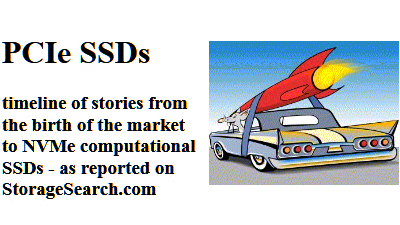| NAS news |
Primary Data contributes
enhancements to Parallel NFS
Editor:- December 7, 2016 - Primary Data today
announced
that its open standards Parallel NFS (pNFS) contributions developed to
seamlessly orchestrate data across different types of storage have been accepted
into the NFS 4.2 standard.
Among
other
things the company's contributions to NFS 4.2 include enhancements to the
pNFS Flex File layout to allow clients to provide statistics on how data is
being used, and the performance provided by the storage resources serving the
data.
new MIL-STD-461E/F EMI filtered NAS JBOD SSD from V&G
Editor:-
August 24, 2016 - I found it interesting to see the level of detail available
in the datasheet for a new rugged 8TB NAS JBOD SSD box (8.66 in (L) x 7.61 in
(W) x 4.65 in (H)) from V&G
because often such vital info is missing unless you sign up to get it. Among
other things - the
RVAS3400
(pdf) has these features and options:-
 256-bit
AES encryption utilizing NIST, CSE, and FIPS140-2 certified encryption chips.
Encryption keys can be loaded over ethernet or stored on the system's
controller. The controller has a TPM security device for secure storage of the
encryption keys. 256-bit
AES encryption utilizing NIST, CSE, and FIPS140-2 certified encryption chips.
Encryption keys can be loaded over ethernet or stored on the system's
controller. The controller has a TPM security device for secure storage of the
encryption keys.
The RVAS3400 supports zeroization (SSD erase) procedures,
meeting both DOD NISPOM 5220.22 and NSA/CSS 9-12 specifications.
The
time to erase using ATA Secure Erase is approximately 5 seconds, using NSA Erase
it is approximately 16 minutes, and using DOD Erase it is approximately 48
minutes. (Erase times do not vary based on the amount of storage.)
- Internal holdup:- 100ms @ 70W.
- Integrated support for MIL-STD-704 28 VDC.
- Weight:- less than 12 lbs.
See also:-
the business of SSD
customization
Pivot3 acquires NexGen
Editor:- January 27, 2016 -
NexGen Storage
announced
today it has agreed to be acquired by Pivot3.
Editor's comments:- The last time I wrote about Pivot3 was 7 years ago.
I had a good feeling about their
big controller
architecture thinking which was being applied to hard drive arrays but
I viewed it more as a valuable
efficiency boost to
buy breathing space for the
last gasp years of
enterprise HDD rather than the new direction I was focused on - which was
heading towards the solid state storage datacenter. And so - from my point of
view - I had nothing more to say.
On the other hand we're heard
about NexGen
many
times in recent years.
Combining the software and architecture from
these 2 companies could produce a platform with characteristics comparable to
the best upwardly stretched efforts of much better known competitors if
Pivot3 and NexGen can draw the integration boundaries in the right places (and
get it done quickly enough).
SolidFire to be acquired by NetApp
Editor:-
December 21, 2015 - Network
Appliance has agreed to acquire SolidFire for $870
million in cash according to an
announcement
today - which also said that "with SolidFire, NetApp will now have
all-flash offerings that address each of the 3 largest AFA
market
segments."
Pure Storage reports high revenue growth
Editor:-
December 2, 2015 - Pure
Storage
reported
that revenue in the recent quarter was $131.4 million - which was 2.6x
the revenue of the year ago period.
Pure Storage said it grew its
customer base to over 1,350 organizations, adding more than 250 new customers in
the third quarter, including Domino's Pizza and The Boston Globe. Existing
customers ConocoPhillips, LinkedIn and ServiceNow also expanded the scope of
their relationships with Pure Storage.
Editor's comments:-
Pure Storage's revenue in the most recent quarter was approximately 10x
the revenue
reported
today by Violin.
dual port GbE and USB in the same M.2 SSD from InnoDisk
Editor:-
November 3, 2015 - InnoDisk
today
announced
a product first for the M.2 SSD
market in the shape of a dual port isolated GbE compatible model -
EGUL-G201 - which also has a USB
3 interface, and fits in a 22x60mm footprint. InnoDisk says the ethernet modules
have strong electrical isolation, ESD and surge protection.
NVMe over GbE - incredible latency from Mangstor
Editor:-
September 16, 2015 - In a conversation with Mangstor I saw some
impressive competitive benchmarks - and even more impressive - a low box to box
latency which is delivered by their NVMe over GbE - which is almost unbelievable
and which will enable the viability of new applications which until now have
required risky new technologies like top of rack PCIe fabrics - from
PLX and
A3CUBE.
Can
a company with less employees than cores in its SSD controller be significant
for the market? ...read
more
Toshiba demonstrates 3.5" ethernet hybrid
Editor:-
May 18, 2015 - Toshiba
today
announced
demonstrations of a new hybrid drive which combines HDD and flash in a
3.5" form factor
with an Ethernet interface.
Editor's comments:- for reasons
which were obvious to systems architects 10 years ago - and haven't changed
today - you will always get better control of performance and cost by designing
a hybrid storage array
with distinctly separate HDDs
and SSDs compared to combining both these functions in a single type of drive.
But
the dream of combining these functions in a single drive to add value to hard
drives does re-emerge in different guises from time to time.
The
only merit I can see to such a product - as the new hybrid from Toshiba - is
that if you have very simplistic and primitively designed systems
software, combined
with using large arrays in a single type of applicaton - then combining both the
flash and magnetic storage in a single drive could simplify the
high availability
aspects of the design by spreading the risk and consequences of drive failures
in a homogenistic way which makes writing the software easier.
In the
consumer market -
where we've seen most of the past market experiments with
hybrid drives
- it doesn't matter if the product is withdrawn from the market after a year or
so - because the design costs only have to make sense for a brief window of
market opportunity.
But in the enterprise market - the risks of
committing an array design to a drive type which is single sourced and hasn't
got an independently arguable credible future roadmap means that such system
implementations are rare.
Unified Storage in the SSD Age
Editor:- October 31,
2014 - Unified Storage... What does that really mean?
Skyera is putting a
lot of effort into joining something which looks a lot like an old fashioned
English gentleman's club (think- Forsyte Saga or Sherlock Holmes). But we know
that the current members of the club are so old they will die soon anyway. So is
it worth it? See SSD
news - October 2014 for more.
Maxta invests in Intel
Editor:- August 19, 2014 - In
May 2014 we
learned that Intel
had invested in Maxta.
And this week we learned that Maxta has reciprocated that favor by investing in
Intel.
More strategically than with mere money - Maxta's
investment -
announced
yesterday - is in the form of a reference architecture - cored on Maxta's
MxSP software (SSD ASAP software)
which provides an easy to support set of solutions preconfigured for Intel
servers and Intel SSDs.
Maxta says its MaxDeploy Reference Architecture
offers the framework of a repeatable and standard deployment model - which
provides its customers "ease of ordering and predictability" - and
which mitigates the risk of hardware or software compatibility issues, while
simplifying and shortening deployment time and training.
SSD brand leaders - from IT Brand Pulse
Editor:-
July 17, 2014 - Based on votes by end users in its survey sample groups -
IT Brand Pulse
today
named
the "2014 SSD Brand Leaders".
Among others - the IT Brand
Pulse "Innovation Leaders" included these companies and
categories:-
Editor's comments:- with so many companies now doing market
research which intersects with the SSD market - you've now got more sanity
checks than ever to determine whether your assessment of any particular SSD
company is broadly in line with that of other people.
Brand
awareness, financial reports and online search data - intrinsically provide
different numerically weighted views of the same market. And which methodology
you prefer depends on whether your priority is in understanding the past,
present or future - and what it is you're trying to decide.
For
longitudinal market studies you can refine your understanding of shifting
patterns of market change and real leadership by comparing these different
types of data and correlating the movements in different time periods. So a
shift in search volume in one period may correlate to a change in revenue some
time later. Or a change in revenue or profitability might be seen to be tied to
a change in brand strength later.
The interesting thing about the SSD
market is that because the technology hasn't been standing still - it can be
shocking to compare the same list and see how it changes over a period of 3 to
5 years and to see which old names have disappeared and which new ones have
replaced them. I'm often reminded of this when I trawl back through my own
SSD history
and news archives. I'm sure it's the same for many of you too.
One of
the things we all hope to get out of these lists - is to avoid making too many
bad bets on companies and technologies which will prove to be a waste of our
time.
See also:-
SSD market analysts,
Can you
trust SSD market data?
Coho Data now shipping 2U MicroArray hybrids
Editor:-
March 6, 2014 - Coho
Data today
announced
general availability of its first product - a 2U SSD ASAP called the
DataStream
(an SSDserver 4/E box) - which
integrates PCIe SSDs,
hard drives and a
server into a web scale expandable unit (using an internal 52 port 10GbE fabric
switch) to implement what the company refers to as a "MicroArray"
designed with the philosophy of
"Turning
Tiering Upside Down (pdf)" to deliver a base building block unit of
180K IOPS
performance (4KB).
Editor's comments:- you can judge the lofty
scale of Coho Data's
ambitions by this market
soothsayer quote which they integrated in the launch press release - ""By
2017, Web-scale IT will be an architectural approach found operating in 50% of
Global 2000 enterprises."
See also:-
SSD empowered cloud,
SSD hybrid arrays,
the enterprise SSD
software event horizon
aligning database block sizes with SSDs
Editor:-
February 5, 2013 - I often hear from readers designing
software for SSDs who
- having researched the subject of
flash etc - have
spent too much time over-worrying about internal SSD hardware details that
they really shouldn't be worrying about. Because by the time they learn about
such things - that type of hardware anxiety is ancient history.
Today
I came across a recent blog by Chas. Dye at Pure Storage
called
Please
DON'T Fiddle with Your Database Block Size! - which also warns about this
very issue.
Chas says - "At Pure Storage, we believe that a factor
that should never influence the block size decision is your storage subsystem."
Editor's
comments:- I'd certainly agree that trying to slavishly make your data
structures look like something you've read about which might be inside an
SSD controller is
probably a waste of time - because unless you know the SSD designer you don't
really know what's going on - and the abstraction you read about in some web
site is only a small part of the picture.
If an
SSD is so sensitive to
the data you hit it with - it's not the SSD you should have bought in the
first place.
Nutanix has a new NFS for PCIe SSD accelerated CPUs
Editor:-
June 12, 2012 - Nutanix
today
Nutanix
announced the general availability of NDFS (Nutanix Distributed File
System), a bold new distributed filesystem that has been optimized to leverage
localized low latency PCIe
SSDs such as those from Fusion-io.
By
shifting the NFS datapath away from the network directly onto the VMware vSphere
host, NDFS bypasses network communications that have historically been fraught
with multiple high-latency hops between top-of-rack and end-of-row switches.
Nutanix accelerates both read and writes for any workload.
Redundancy and
availability are achieved by data mirroring across high-speed 10GbE
switches. Nutanix says it harnesses the same distributed system techniques
that power webscale clouds such as Google, Amazon, and LinkedIn clouds into an
enterprise-friendly package that starts out as a high-density 2U datacenter
rack.
Editor's comments:- Nutanix is in the
SSD ASAP market -
with CPU-SSD
equivalency architecture integrated in the OS. The company says their
architecture "collapses compute and storage into a single tier." You
can get the general idea from their
blog and
video.
Conduction cooled rugged NAS SSDs find seats in war-planes
Editor:-
November 1, 2011 - Curtiss-Wright
today announced that it has received a contract from Lockheed Martin
Aeronautics to provide its rugged conduction cooled NAS SSDs -
Vortex CNS
products - to the U.S. Air Force's
HC/MC-130J
Super Hercules aircraft program.
The initial order is valued at
$800,000, with a potential lifetime contract value estimated at $7.5 million.
See also:-
military SSDs
Violin does that NFS ops - with SSDs - thing
Editor:-
November 17, 2010 - Violin
Memory (which makes
rackmount SSDs)
recently unveiled a
multi-terabyte
SSD cache solution for NAS
systems which use NFS.
Violin says its
vCACHE expands to
15TB of useable cache and delivers over 300,000 NFS operations per second over
8x 10GbE ports. It uses software from
Gear6 which Violin
acquired in June 2010 after the
software developer had
burned its way through $24 million
funding and crashed.
Editor's
comments:- I spoke to
Don
Basile, CEO of Violin Memory, and
Matt
Barletta. ...click
to read interview
Nexenta streams online tv
Editor:- May 20, 2010 -
Nexenta Systems
announced
that its products (which include
SSD ASAP features)
are being used by the Dutch Public
Broadcasting Agency NPO for storing and delivering online tv in a
configuration which includes 192TB of
hard disk drives and a
1.9TB SSD read cache.
The
broadcaster's website has approximately 80TB of video available to online
users who want to watch previously broadcasted television programs. During an
average evening, between 10 and 20,000 people stream data, adding up to 25GB in
capacity. The customer (who evaluated multiple vendors ) says that important
selection criteria were:- performance, price, support and power
consumption. | |
| . |
|
|
| . |
|
|
|
 | |
|
|
|
|
| . |
 |
| ... |
|
|
| . |
re micro tiering and micro
clouds
One of the trends in computer architecture in recent years is
that new software architectural concepts which deliver sustainable efficiency or
management efficiencies have found it easier to get their benefits recognized
at a large scale - as part of big web entities or cloud infrastructure.
The lessons learned have been duly noted and reapplied to other use
cases and are now finding their way into individual rack scale products too. |
| 10 key SSD
ideas which clarified in 2014 | | |
. |
 |
. |
| SSD Pricing -
where does all the money go? |
SSDs are among the most
expensive computer hardware products you will ever buy.
Understanding
the factors which determine SSD costs is often a confusing and irritating
process... |
 |
...not made any easier when
market prices for identical capacity SSDs can vary more than 100x to 1!
Why is that? ...read
the article | | | |
. |
What's the
best way to design a flash SSD?
and other questions which split SSD
opinion |
| More than 10 key areas of
fundamental disagreement within the SSD industry are discussed in an article
here on StorageSearch.com called
the
the SSD Heresies. |
 |
... |
Why can't SSD's true believers agree upon
a single coherent vision for the future of solid state storage? ...read the article | | | |
| . |
|
|
. |
 |
. |
| "The winners in SSD
software could be as important for data infrastructure as Microsoft was for
PCs, or Oracle was for databases, or Google was for search." |
| all enterprise data
will touch an SSD | | |
| . |
| |
